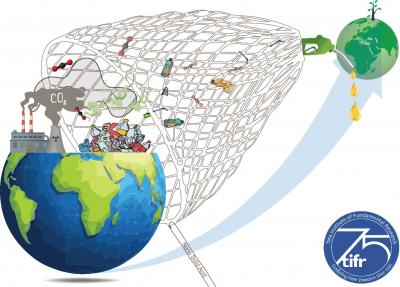Nano-sponges of solid acid transform carbon dioxide to fuel and plastic waste to chemicals

Nano solid acids that transform carbon dioxide directly to fuel(dimethyl ether) and plastic waste into chemicals (hydrocarbons). Credit: Ayan Maity,TIFR, Mumbai
Two best known solid acids are crystalline zeolites and amorphous aluminosilicates. Although zeolites are strongly acidic, they are limited by their inherent microporosity, causing extreme diffusion limitation, whereas aluminosilicates are although mesoporous, they suffer from low acidity and moderate stability.
Thus, it is a synthetic challenge to design and synthesize solid acids with both strong acidities like zeolites and textural properties like aluminosilicates, speculated as “Amorphous Zeolites”, which are ideally strongly acidic amorphous aluminosilicates.
On the other hand, the primary cause of climate change is atmospheric carbon dioxide, whose levels are rising every day. The effect of global warming in terms of drastic changes in weather patterns is already clearly visible and alarming.
There is, therefore, a great need to find ways to reduce carbon dioxide levels, either by sequestering it or by converting it to fuel. On the other hand, an excessive amount of plastic waste has become a serious environmental problem. Most of the countries generate thousands of tonnes of plastic waste every day.
In this work, researchers dealt with both these problems at one stroke, by developing nano solid acids that transform carbon dioxide directly to fuel (dimethyl ether) and plastic waste to chemicals (hydrocarbons).
By using the techniques of bicontinuous microemulsion droplets as a soft template, Prof. Vivek Polshettiwar's group at Tata Institute of Fundamental Research (TIFR), Mumbai, synthesized an acidic amorphous aluminosilicate (AAS), speculated as “Amorphous Zeolites”, with a nano-sponge morphology, exhibiting both zeolitic (strong acidity) and amorphous aluminosilicate (mesoporous high surface area) properties.
The presence of zeolite-like bridging silanol in AAS was proved by various catalytic reactions (styrene oxide ring-opening, vesidryl synthesis, Friedel-Crafts alkylation, jasminaldehyde synthesis, m-xylene isomerization, and cumene cracking) which requires strong acidic sites and larger pore sizes.
The synergy between strong acidity and accessibility was reflected in the fact that AAS showed better performance than state-of-the-art zeolites and amorphous aluminosilicates. This was also confirmed by detailed solid-state NMR studies.
Thus, it was clear that the material possesses strongly acidic zeolite-like bridging silanol sites, even though materials are not crystalline but amorphous. They, therefore, fall into a new class of materials at the interface between crystalline zeolite and amorphous aluminosilicate.
Thus, the approach may allow the development of solid acid catalysis for plastic degradation as well as carbon dioxide to fuel, at the significant rates, scales, and stabilities required to make the process economically competitive. The protocol has scientific and technological advantages, owing to its superior activity and stability.
Media Contact
More Information:
http://dx.doi.org/10.1038/s41467-020-17711-6All latest news from the category: Life Sciences and Chemistry
Articles and reports from the Life Sciences and chemistry area deal with applied and basic research into modern biology, chemistry and human medicine.
Valuable information can be found on a range of life sciences fields including bacteriology, biochemistry, bionics, bioinformatics, biophysics, biotechnology, genetics, geobotany, human biology, marine biology, microbiology, molecular biology, cellular biology, zoology, bioinorganic chemistry, microchemistry and environmental chemistry.
Newest articles

A ‘language’ for ML models to predict nanopore properties
A large number of 2D materials like graphene can have nanopores – small holes formed by missing atoms through which foreign substances can pass. The properties of these nanopores dictate many…

Clinically validated, wearable ultrasound patch
… for continuous blood pressure monitoring. A team of researchers at the University of California San Diego has developed a new and improved wearable ultrasound patch for continuous and noninvasive…

A new puzzle piece for string theory research
Dr. Ksenia Fedosova from the Cluster of Excellence Mathematics Münster, along with an international research team, has proven a conjecture in string theory that physicists had proposed regarding certain equations….



